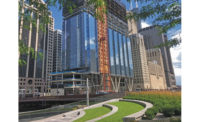McCarthy Building Companies, Inc. has been selected to build the Center for Disease Control and Prevention’s new High Containment Continuity Laboratory at its’ Roybal Campus in Atlanta. It will be one of three facilities in the world designed and certified to facilitate diagnosis on specific, select viruses.
McCarthy has built more than 25% of the biolevel 4 facilities in the U.S. and more than 50% of the gross sq ft of such labs in the U.S.
CDC has chosen McCarthy as construction manager as constructor (CMc) of the estimated $350-million project that will support the CDC’s public health mission. That cost estimate was based on CDC's 2018 appropriations request for a 95,000 sg ft building and the project has grown to 160,000 sq ft since, so it may cost considerably more.
The multi-story research building is part of the CDC’s 2025 master plan, which was finalized prior to the COVID-19 outbreak. The facility will support the CDC’s mission of helping communities prepare for, detect and respond to the consequences of public health hazards. The laboratory will accommodate 80 laboratory researchers and will be a Biosafety Level-4 facility, a designation indicating the highest level of biological safety.
Biological Safety Levels (BSL), from one to four, refer to a series of highly regulated precautions designed to protect personnel, as well as the surrounding environment and community. Biosafety levels are a key influence on the overall design of a facility as well as the type of specialized safety equipment used.
Bobby Campbell, executive vice president of McCarthy in Atlanta, said the company brings 20 years of experience to the project.
“McCarthy has constructed the majority of the BSL-4 laboratories in the U.S., including the completion of the BSL-4 Emerging Infectious Diseases Laboratory on this campus 15 years ago,” he said. “We are looking forward to bringing our experience full circle back to the CDC to build an efficient, functional, and technologically advanced research laboratory.”
As a BSL-4 laboratory, the new facility will feature high-efficiency particulate air (HEPA) filtered supply and exhaust air, air pressure resistant doors, pressure cascade zoning, effluent collection and treatment, and pressure decay tested coatings and penetrations, as well as high purity breathing air and chemical decontamination showers for research staff. There will be connections to the existing Roybal campus utility systems with below-grade utility tunnels and a two-level bridge connection.
The project is currently is in the preconstruction/design phase with construction slated to start in early 2021.
McCarthy’s other biosafety projects have included Boston University and the U.S. Department of Agriculture in Ames, Iowa and Manhattan, Kansas.
The CDC has selected Flad Architects, Page Southerland Page, and WSP to plan, program, and design the HCCL. Flad has knowledge and experience in biosafety projects, and is currently working with McCarthy on the National Bio and Agro-Defense Facility (NBAF) in Manhattan, Kansas, the only BSL-4 large animal facility in the nation.





Post a comment to this article
Report Abusive Comment